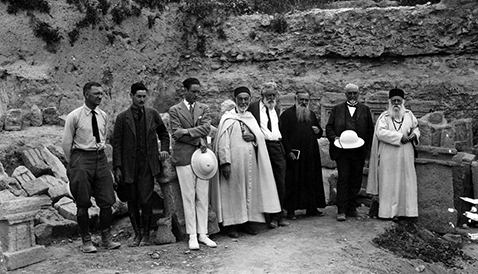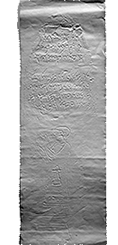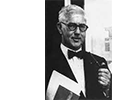|
|
AMERICAN EXCAVATIONS AT THE PRECINCT OF TINNIT & BAᶜL
University of Michigan • F. W. Kelsey, 1925
In 1921 the first excavations at the precinct itself were undertaken by two amateurs, a French customs agent and a police inspector ( Icard 1922). After having followed a trafficker in illicit antiquities and having purchased the plot of land where he had been extracting stelae ( propriété Regulus-Salammbô), the two commenced digging themselves. Authorities of the French protectorate from the Service de Antiquités soon intervened to supervise ( Poinssot & Lantier 1923). At the same time an American socialite and self-styled “count,” Byron Kuhn de Prorok, pressented himself as the site's excavator and maneuvered to purchase this plot and other properties threatened by the suburban expansion of Tunis. He had the assistance of the abbé J.-B. Chabot, an epigrapher and member of the French Académie ( AIBL), as well as the support of the Rev. A.-L. Delattre MAfr, a relentless excavator of ancient Carthage and curator of the Musée Lavigerie de Saint-Louis. Both scholar-priests lent legitimacy to his campaign in 1924 ( Chabot 1924; de Prorok 1925).
Delattre excavation records and correspondence • GAMAfr |
|

University of Michigan excavation staff, May 1925
l to r: Enoch E. Peterson, George F. French, Byron Khun de Prorok, Rev. Edmond Huguenot MAfr, Henry S. Washington, abbé Jean-Baptiste Chabot, Francis W. Kelsey, Rev. Alfred-Louis Delattre MAfr
©2023 KMA Carthage Excavation Archives (G. R. Swain 7.2054)
|

|
The Khun de Prorok had enlisted inexperienced volunteers, including Donald. B. Harden (from the British School at Rome via Cambridge University), G. Rey de Vilette (from the École des Sciences Politiques) and the teen-aged Horton O'Neil (from a Parisian boarding school). The three were invited back the following year to rejoin his “Franco-American“ campaign, soon to be under the scientific supervision of F. W. Kelsey. Upon arrival in 1925, however, Kelsey found to his dismay that enthusiastic unsupervised excavation had already begun ( Pedley 2012, KMA Kelsey Diary 4 March 1925). Extraction of urns and stelae continued at a breakneck pace with only limited recording of contexts, although they could recognize in the stratigraphy three phases of use ( Kelsey 1926). The KMA archives preserve brief descriptions of stratigraphic contexts in excavation diaries and on registry cards, as well as site plans and area surveys. Certain stelae from both seasons were photographed by G. R. Swain for the abbé Chabot, accompanied by squeezes ( Bruehl 1997-2000) and by line drawings made under the supervision of E. R. Stoever. In addition, the KMA and BHL hold correspondence between Kelsey and his team, his institutional supporters, and the French protectorate authorities.
sample: dedication of BᶜLᶜZR ( CIS I.3784, Alaoui Cb–442)
©2023 KMA Carthage Excavation Archives ( box 3.6: T2019.030, Bruehl 21)
Kelsey excavation records and correspondence • KMA • BHL • OpenContext
|
 |
Donald B. Harden had been recruited as a volunteer in 1924 while a student at Trinity College Cambridge on fellowship at the British School in Rome, Before the 1925 season, Harden had begun teaching at the University of Aberdeen but gained leave to return to Carthage. Kelsey gave him responsibility over ceramics (some of which he donated to the British Museum, Hall 1927) and arranged for a Commonwealth Fund Fellowship (1926-28), which Harden used for travel to Ann Arbor to work on his typology. The French protectorate authorities, however, never released the hundreds of ceramics designated for study, so he switched his focus to studying glass from the University of Michigan excavations at Karanis in Egypt. Despite this setback and the untimely death of Kelsey in 1927, after having accepted a position as assistant to the Keeper of Antiquities at the Ashmolean Museum, he did eventually return to Carthage in 1933 and published his still valuable ceramic typology (Harden 1937). The ceramics sample made available to him for study in the 1930s was eventually accessioned into the Ashmolean collections, which also hold some of his records and a report on the cremated bones found in his sample urns (Gejvall 1949).
Harden artifacts and records • BM • Ashmolean • KMA • OpenContext
|
 |
While the abbé Chabot was more interested in prying out inscriptions than in recording stratigraphic contexts, he did maintain a collection of photographs, not just of the inscriptions for publication in the Corpus Inscriptionum Semiticarum (CIS I.3708-3905; Picard 1954: Musée Alaoui Cb—255-478) but also field photos with identifiable stelae. Using professional images by G. R. Swain and snapshots by D. B. Harden and H. O'Neil, many stelae can be replaced in situ (Benichou-Safar 1995, 2004). Note that one stela from the 1924 campaign found its way from the hands of de Prorok into the hands of Chabot, and from him to the Université catholique de Louvain (ML MB402 / CIS I.3708).
sample: abbé Chabot inspecting stelae in the field
©2023 KMA Carthage Excavation Archives (Swain 5.473)
Chabot records and correspondence • Archives Chabot • KMA • OpenContext
|
 |
Although just a teenage volunteer, Horton O'Neil left Tunisia in 1925 with steamer trunks full of artifacts, some of which he donated to the Harvard Classics Department in 1965, a portion of which was later transferred to the HAM, Hirschland & Hammond 1968), some his widow donated to the KMA, along with his annotated scrapbooks. The latter donation included nine urns with their contents (Talalay & Root 2015).
H. Dixon (East Carolina University) Re-examining Archaeological “Souvenirs”
©2022 ARF/Badè Museum Unsilencing the Archives
O"Neil artifacts and scrapbooks • HAM • KMA • OpenContext
|
|
|
partners | about
|
AMERICAN EXCAVATIONS AT THE PRECINCT OF TINNIT & BAᶜL
|

|
|

|
HARVARD UNIVERSITY
Harvard Art Museums ( HAM)
S. Ebbinghaus
Horton O'Neil donated to Harvard University a portion of the hundreds of artifacts that he either collected himself or traded for while a teen-aged volunteer and assistant to de Prorok (1924-25). The Department of Classics and HAM hold one portion, Princeton University (his alma mater) another portion, and the KMA a third portion of his collection.
|

|
Harvard Museum of the Ancient Near East ( HMANE)
P. Der Manuelian, A. Aja
Besides hosting the ASOR Punic Project and L. E. Stager archives, the HMANE keeps certain certain duplicate records (e.g. diaries, plans) from the University of Michigan Carthage excavations (1925).
|

|
UNIVERSITY OF MICHIGAN
Kelsey Museum of Archeology ( KMA)
N. Terrenato
The KMA hosts archives from 1920s excavations supported by the University of Michigan Advisory Committee on Near East Research, not only those in Tunisia (Carthage), but also records from Egypt (Karanis, Dimé, Terenouthis) and Asia Minor (Antioch in Pisidia, Sizma). The Bentley Historical Library ( BHL) holds duplicate records as well as Kelsey's correspondence. The museum collection includes squeezes and drawings of inscriptions; field notes and photographs; as well as diaries, scrapbooks, and general registry cards.
|

|
UNIVERSITÉ CATHOLIQUE DE LOUVAIN
Archives de Jean-Baptiste Chabot
A. François
The abbè served as editor of the Corpus Inscriptionum Semiticarum ( CIS) and Répertoire d'Épigraphie Sémitique ( RÉS), both projects recording Phoenician inscriptions for the Académie ( AIBL), and he served as epigrapher for the Kelsey excavations. His archives were donated to KULeuven, then transferred to UCLouvain after the 1968 separation and division of holdings. His archives include correspondence and annotated photographs. In addition, one stela transferred from de Prorok to Chabot now resides in the university's MuséeL ( MB402). |

|
BRYN MAWR COLLEGE
The White Fathers at Carthage
General Archives of the Missionaries of Africa (GAMAfr)
A. Walker (Bryn Mawr) & C. Zitrides Atiyeh
We mirror the methodology of this on-going project, which has been digitizing the archives in Rome of the Missionaries of Africa ( MAfr)—aka Pères Blancs, or White Fathers. Of particular interest is the correspondence of Rev. A. L. Delattre MAfr with F. W. Kelsey and with abbè J.-B. Chabot, as well as the correspondence of Rev. G.-G. Lapeyre MAfr, all of whom were active in the same precinct.
|

|
UNIVERSITY OF OXFORD
Ashmolean Museum
A. Ulbrich
The Ashmolean houses records and artifacts relating to the F. W. Kelsey excavations that were transferred to the museum by D. B. Harden, a key member of the University of Michigan excavations (1925) and a Commonwealth Fellowhip researcher in Ann Arbor (1926-28). He visited Carthage again as an assistant keeper (1933) before becoming Keeper of the Department of Antiquities at the Ashmolean (1945-56). Artifacts from his 1930s study, with Kesey registry numbers, formed the basis of a seminal Punic ceramic typology ( Harden 1937) and are now in the museum's collection.
NB Harden donated a group of ceramics to the British Museum in 1925 that also bear Kelsey registry numbers.
|

|
NORTH AFRICAN HERITAGE ARCHIVE NETWORK ( NAHAN)
E. Fentress
This project priovides a platform for documents from archaeological archives held in a series of European and North African institutions. This open-access resource harvests data from documents already online.
|

|
INSTITUT NATIONAL DU PATRIMOINE (INP)
Musée national de Carthage & Musée national du Bardo
I. ben Jerbania & A. Ferjaoui
Our Tunisian colleagues have supported our efforts toward publication and exhibition, have supported the return of artifacts taken abroad on loan for study, and support in principle our proposed non-destructive analyses of artifacts. We hope to apply the methods from our proof-of-concept exercise to artifacts in Tunisia, with high-definition 3D reproductions limited to those given prior authorization.
|

|
CORPUS INSCRIPTIONUM PHOENICARUM (CIP)
Istituto di Studi sul Mediterraneo Antico (ISCMA)
Centro de Ciencias Humanas y Sociales (CCHS)
P. Xella (ISCMA-CNR/UTübingen) & J.-Á. Zamora (CCHS-CSIC)
Increasing accessibility to Punic inscriptions remains a primary goal of our initiative, and we will build upon the progress of the CIP in making images, transcriptions and commentary available in a searchable digital format.
|
|
|
|